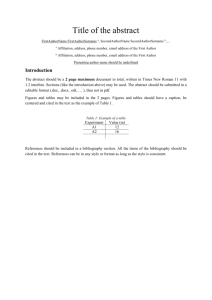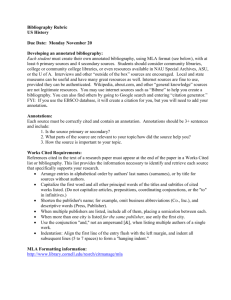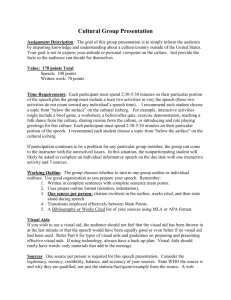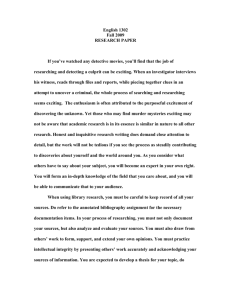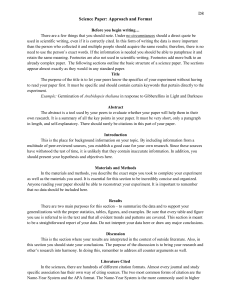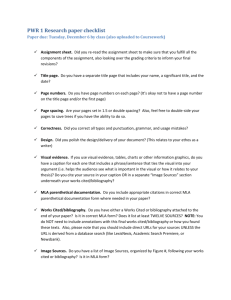Journalism/EMC 3510: Assignment Sheet for Group Paper
advertisement
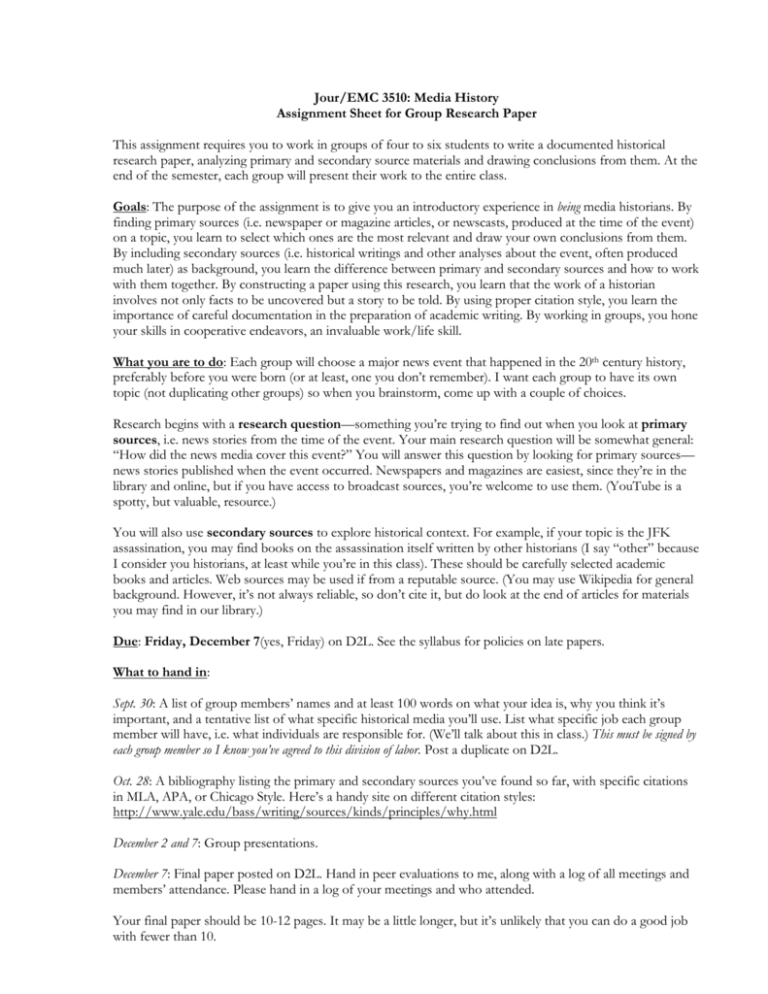
Jour/EMC 3510: Media History Assignment Sheet for Group Research Paper This assignment requires you to work in groups of four to six students to write a documented historical research paper, analyzing primary and secondary source materials and drawing conclusions from them. At the end of the semester, each group will present their work to the entire class. Goals: The purpose of the assignment is to give you an introductory experience in being media historians. By finding primary sources (i.e. newspaper or magazine articles, or newscasts, produced at the time of the event) on a topic, you learn to select which ones are the most relevant and draw your own conclusions from them. By including secondary sources (i.e. historical writings and other analyses about the event, often produced much later) as background, you learn the difference between primary and secondary sources and how to work with them together. By constructing a paper using this research, you learn that the work of a historian involves not only facts to be uncovered but a story to be told. By using proper citation style, you learn the importance of careful documentation in the preparation of academic writing. By working in groups, you hone your skills in cooperative endeavors, an invaluable work/life skill. What you are to do: Each group will choose a major news event that happened in the 20th century history, preferably before you were born (or at least, one you don’t remember). I want each group to have its own topic (not duplicating other groups) so when you brainstorm, come up with a couple of choices. Research begins with a research question—something you’re trying to find out when you look at primary sources, i.e. news stories from the time of the event. Your main research question will be somewhat general: “How did the news media cover this event?” You will answer this question by looking for primary sources— news stories published when the event occurred. Newspapers and magazines are easiest, since they’re in the library and online, but if you have access to broadcast sources, you’re welcome to use them. (YouTube is a spotty, but valuable, resource.) You will also use secondary sources to explore historical context. For example, if your topic is the JFK assassination, you may find books on the assassination itself written by other historians (I say “other” because I consider you historians, at least while you’re in this class). These should be carefully selected academic books and articles. Web sources may be used if from a reputable source. (You may use Wikipedia for general background. However, it’s not always reliable, so don’t cite it, but do look at the end of articles for materials you may find in our library.) Due: Friday, December 7(yes, Friday) on D2L. See the syllabus for policies on late papers. What to hand in: Sept. 30: A list of group members’ names and at least 100 words on what your idea is, why you think it’s important, and a tentative list of what specific historical media you’ll use. List what specific job each group member will have, i.e. what individuals are responsible for. (We’ll talk about this in class.) This must be signed by each group member so I know you’ve agreed to this division of labor. Post a duplicate on D2L. Oct. 28: A bibliography listing the primary and secondary sources you’ve found so far, with specific citations in MLA, APA, or Chicago Style. Here’s a handy site on different citation styles: http://www.yale.edu/bass/writing/sources/kinds/principles/why.html December 2 and 7: Group presentations. December 7: Final paper posted on D2L. Hand in peer evaluations to me, along with a log of all meetings and members’ attendance. Please hand in a log of your meetings and who attended. Your final paper should be 10-12 pages. It may be a little longer, but it’s unlikely that you can do a good job with fewer than 10. Guidelines: Your paper should have an academic tone. It should not be promotional and it should not read like a news story. It must be properly cited using APA, MLA, or Chicago Style, including in-text citations and a Bibliography, Works Cited or Reference page. Please designate which citation style you are using at the top of the paper. “How did the news media cover the event?” is a question that requires you to read primary sources somewhat critically. Don’t just tell me what was said, but how it was said. Your papers will vary, but here are some questions to guide you in doing this: o o o o o How prominently was this story covered? Where was it covered? (i.e. in what specific newspapers, magazines, or other media?) Also, what page was it on, and where on the page? What do you make of that? What does it say about coverage of this event at the time? Who had a “voice” in the story? Who didn’t? Who was interviewed? Be sure to consider diversity here by noticing whether and how women and ethnic minorities were or were not included in the story. Who else might have been interviewed? What do you make of that? Who was pictured? Were pictures used at all? How prominent were they? What story do they tell? How do they complement or contrast with the story? What do you make of that? What’s around the story? Stories on what other topics? What ads? Don’t forget editorials. What do you make of that? What do the details, the selection of interviewees, the tone of the story, the placement of the story and other, similar clues tell you about who the audience is? This is not a simple question of “target market” but of “interpellation”—a cultural studies term that roughly means how the story calls out to the audience, what assumptions are made about readers and their attitudes. In other words, who do you think the writers, photographers, and editors thought about the beliefs of the audience? How do you know? What do you make of that? “Historical context” includes factual information about the event itself, as told by academic sources, i.e. books and academic articles written. It may include information gleaned from the Web if the writer is an academic source. It may also include what historians have to say about media coverage. We will discuss structure of the paper more fully in class. Here’s one good way to organize it: o o o o an introduction, explaining the topic, why it’s important, and your thesis statement. You may want to include historical context from secondary sources in this section. Be sure to include a clear thesis statement, which might begin, “This paper contends that…” Ask yourselves what’s at stake here. What is the main thing you want the reader to see about your interpretation of media coverage? a segue (transition) to the main section, where you focus on news coverage. a discussion of how the media coverage compares to what’s known about the event itself, i.e. some comparison between primary and secondary sources. This should be the lengthiest part of the paper. a conclusion. How does media coverage compare to “historical memory,” to the way the event is generally remembered and to what you previously thought about it? What else could be explored about this topic? the all-important Bibliography or Works Cited page! How to get a failing grade on this paper: Hand in someone else’s analysis of media coverage. This refers not only to plagiarism, but to summarizing published academic work that analyzes media coverage. For example, you find the perfect book on how newspapers covered the Columbine shootings. You summarize it and hand that in rather than going to find your own news coverage of the event and providing your own analysis. Even if you cite the book, this will earn a failing grade because it does not do what the assignment asks. Evaluation: The paper and presentation are worth 300 points. The overall grade for the research project will be broken down as follows: o o o o o Well-articulated idea: not graded, but you lose 10 points per day that it’s late Bibliography due: 25 points Presentation: 50 points Paper itself: 200 points Peer evaluation for each member: 25 points (individual grades) The written paper itself (200 points) will be evaluated according to these criteria: o Research is thorough and adequate to answer the question. It includes both primary and secondary sources. _______/75 o Interpretation: Research is discussed in a thoughtful, logical way. What you conclude makes sense, given the research that you document. You answer most of the questions above, or bring up other issues that you analyze in a clear way______/75 o Writing: The paper is written using clear sentences and paragraphs. It is focused and includes a clear thesis statement that answers the question posed by the assignment. Grammar, mechanics, and spelling are all correct. It is engaging to read. The paper is properly cited, using MLA, APA or Chicago Style._______/50 TOTAL for Paper___________/200. Regarding group work… Group work requires cooperation among individual students to work for the good of all. This is often foreign in a culture such as ours that values individual achievement, and in which students may have different personal values about grades and education. It is, however, inevitable that you will have to work with peers on committees and projects in your working lives, and that there may be times when your very livelihoods depend on your ability to do this well. That said, it is understandable that students feel anxious about working with others when part of their own grades are at stake. For this paper, you have to work in groups. That’s not negotiable. However… You will choose your own groups Each group will choose its own topic, within the parameters of the assignment Each group member will turn in an evaluation on other group members, which will count as 25% of each student’s research paper grade. (In the past this has been a bonus, since despite initial anxiety, most groups work well together and everyone gives everyone else an ‘A’.) While the presumptive grade for the project will be the same for all members, in cases where it is clear to me that a member has not contributed his or her fair share, or that another member has done a disproportionate amount of work, I will adjust individual grades for the project accordingly. (This will be indicated only to the students in question, obviously.) In the case of seemingly irreconcilable differences, groups may have a conference with me to try to work problems out. All members must attend. However, please remember that scapegoating a group member is unprofessional and may lower your own participation grade. Any of you are welcome to come talk to me at any time (but keep in mind what I said about scapegoating). All that said, this project can be fun. In the past, students have done wonderful projects, learned a lot about media history, and worked well with one another. Enjoy what you learn in this project. Please ask for help when you need it to make your work the best that it can be. Jour/EMC 3510 Checklist for Research Project Before turning in your paper, each member of the group should go over this checklist. 1. Does the paper have a compelling introduction that explains what the topic is and why it’s worth examining? 2. Does the paper have a thesis statement that clearly states not just your topic but your argument, based on what you found out in your research? 3. Is the paper based primarily on what you have concluded through your own analysis of primary source media materials from the time of the event? Is it clear that it is about media coverage of the event and not the event itself? 4. Have you thoroughly analyzed the primary source media materials yourselves to show your readers how you came to the conclusions that you did? Do you include properly cited quotes from the primary sources to show how you drew your conclusions? 5. Do you use background information from secondary sources to provide context for the media coverage? 6. Do the parts written by different members flow together smoothly? Does the paper read like a cohesive whole, rather than a collection of disjointed parts? 7. Have you properly cited every little thing that did not come out of your heads, using an academic citation style (Chicago, APA, or MLA)? 8. Do you have a clear bibliography done in the proper citation style? Does it include everything you cited, and leave out items you didn’t use? 9. Did you proofread? 10. Did you proofread again? Remember: A thesis statement tells more than the topic. It clearly states your argument. You may have a tentative idea when you start out, but need to decide what your argument really is near the end, after you’ve analyzed your primary sources and discussed them among yourselves. Wrong: This paper examines how Marilyn Monroe’s death was covered in three American newspapers. (That tells the topic, but not the argument.) Better: This paper shows that coverage of Marilyn Monroe’s death in at least three American newspapers emphasized her rocky love life and celebrity identity, paying little attention to Norma Jean--the person she really was. (Here, you’ve drawn conclusions based on your analysis and stated a clear argument One way to find your thesis is to ask yourselves what’s at stake in the paper--what main idea do you want to prove to readers through the examples you show? How can you state it succinctly? So that you’re not scrambling to figure this out the night before the paper is due, try checking in with one another as you work, asking, “Okay, what conclusion is emerging here?” Also, try organizing paragraphs using the PIE structure: Point, Illustration, Elaboration, clearly stating your point, providing a primary source illustration to back it up, and following through with more elaboration. Here’s an example: (P): In subtle ways, newspapers’ coverage ridiculed those who protested entry into the war by comparing them to 1960s “hippies” who protested the Vietnam war. (I): “They came in love beads and carrying homemade signs,” noted the Name of Newspaper. “Not since their parents grooved at Woodstock had young people taken to the streets like this.” Similarly, the Name of Other Newspaper noted their peace signs and wondered where the “Make Love, Not War” signs were. (E): By casting the current protest in terms of the 1960s, the newspapers trivialized the current protesters’ message, as if opposition to military involvement were by nature anachronistic and juvenile.




